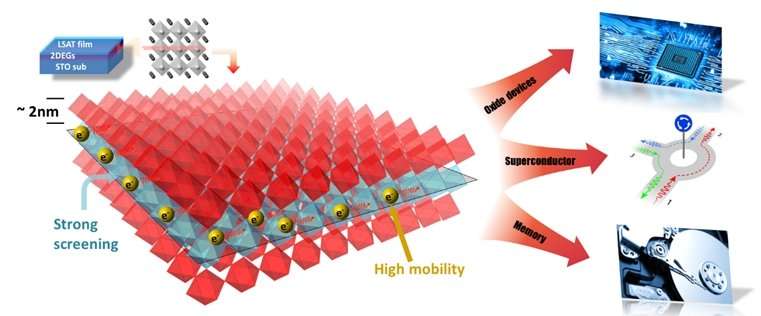An expressway for electrons in oxide heterostructures

NUS physicists have developed a new methodology for determining the impact of screening effects on charge carrier mobility at the interface of complex material structures.
Oxide heterostructures, which are composed of layers of different oxide materials, exhibit unique physical properties at their interfaces (junction between two oxide materials). These properties do not exist in their parent compounds. An example is the oxide heterostucture comprising a film of lanthanum aluminate (LaAlO3) on strontium titanate (SrTiO3) that can show both insulating and conductive properties depending on the thickness of the film. When the LaAlO3 film thickness is increased and becomes 4 unit cells (~20 nm) or more, the material properties at the interface abruptly change from being electrically insulating to electrically conducting (metallic) with high electron mobility (the speed of the flow of electrons). However, there is limited understanding on the mechanism of this high electron mobility and the physical parameters that influence this unusual behaviour.
The research team co-led by Prof Andrivo RUSYDI and Prof ARIANDO, both from the Department of Physics and Nanoscience and Nanotechnology Institute (NUSNNI) NanoCore, NUS has developed a new methodology involving a combination of advanced measurement techniques (spectroscopic ellipsometry, synchrotron-based soft X-ray absorption spectroscopy and charge transport measurements) to determine the influence of localised charges on the mobility of electrons at the oxide interface. These localised charges can shield (or "screen") electrons in such a way that they do not "see" each other, significantly reducing the coulomb repulsion between them. Screening the coulomb repulsion helps to reduce correlation effects between electrons. This is known as the "screening effect" and it allows the electrons at the interface to travel with higher mobility. The new method developed by the NUS research team allowed them to detect both screened and unscreened electrons, thereby shedding light on how they dictate the electronic properties of a complex oxide heterostructure, particularly at a buried interface.
The researchers involved in this team have applied this method to an oxide heterostructure made up of lanthanum strontium aluminium tantalate ((La0.3Sr0.7)(Al0.65Ta0.35)O3 (LSAT) and SrTiO3. They discovered the presence of a new midgap state populated by localised charges (which are transferred from the surface of LSAT) at the interface. A midgap state is a state occurring within the optical band gap. Interestingly, they found that such a midgap state is responsible for determining the transport properties of the interface. When there are more localised charges at the interface, the mobile electrons are further shielded from those in the surrounding bulk material. This significantly increases the interface electron mobility.
The researchers also found that the electron mobility increases with LSAT layer thickness and is associated with an increase in the midgap state (having more localised charges). The electronic screening effect plays a dominant role in electron mobility at the interface, which in this case resulted in an enhancement of electron mobility by more than 25 times.
Prof Rusydi said, "Our finding shows the importance of the electronic screening effect in determining electron mobility at the interface of complex oxide heterostructures. The experimental techniques developed provide a new methodology for studying the properties of a buried material interface. With these new insights, material scientists can develop advanced materials with unique properties for new device functionalities."
More information: Xiao Chi et al. Large Enhancement of 2D Electron Gases Mobility Induced by Interfacial Localized Electron Screening Effect, Advanced Materials (2018). DOI: 10.1002/adma.201707428
Journal information: Advanced Materials
Provided by National University of Singapore



















